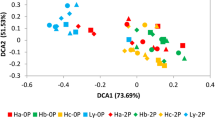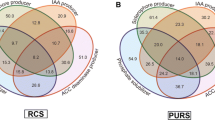Abstract
The rhizospheric bacteria play key role in plant nutrition and growth promotion. The effects of increased nitrogen inputs on plant rhizospheric soils also have impacted on whole soil microbial communities. In this study, we analyzed the effects of applied nitrogen (urea) on rhizospheric bacterial composition and diversity in a greenhouse assay using the high-throughput sequencing technique. To explore the environmental factors driving the abundance, diversity and composition of soil bacterial communities, the relationship between soil variables and the bacterial communities were also analyzed using the mantel test as well as the redundancy analysis. The results revealed significant bacterial diversity changes at different amounts of applied urea, especially between the control treatment and the N fertilized treatments. Mantel tests showed that the bacterial communities were significantly correlated with the soil nitrate nitrogen, available nitrogen, soil pH, ammonium nitrogen and total organic carbon. The present study deepened the understanding about the rhizospheric soil microbial communities under different amounts of applied urea in greenhouse conditions, and our work revealed the environmental factors affecting the abundance, diversity and composition of rhizospheric bacterial communities.




Similar content being viewed by others
References
Vitousek PM, Hättenschwiler S, Olander L, Allison S (2002) Nitrogen and nature. Ambio 31:97–101. doi:10.1579/0044-7447-31.2.97
Ramirez KS, Craine JM, Fierer N (2012) Consistent effects of nitrogen amendments on soil microbial communities and processes across biomes. Glob Change Biol 18:1918–1927. doi:10.1111/j.1365-2486.2012.02639.x
Shen W, Lin X, Shi W, Min J, Gao N, Zhang H, Yin R, He X (2010) Higher rates of nitrogen fertilization decrease soil enzyme activities, microbial functional diversity and nitrification capacity in a Chinese polytunnel greenhouse vegetable land. Plant Soil 337:137–150. doi:10.1007/s11104-010-0511-2
Shen W, Lin X, Gao N, Zhang H, Yin R, Shi W, Duan Z (2008) Land use intensification affects soil microbial populations, functional diversity and related suppressiveness of cucumber Fusarium wilt in China’s Yangtze River Delta. Plant Soil 306:117–127. doi:10.1007/s11104-010-0511-2
Jorquera MA, Martínez OA, Marileo LG, Acuña JJ, Saggar S, Mora ML (2013) Effect of nitrogen and phosphorus fertilization on the composition of rhizobacterial communities of two Chilean Andisol pastures. World J Microbiol Biotechnol 30:99–107. doi:10.1007/s11274-013-1427-9
Spalding RF, Exner ME (1993) Occurrence of nitrate in groundwater—a review. J Environ Qual 22:392–402. doi:10.2134/jeq1993.00472425002200030002x
Caballero-Mellado J, Onofre-Lemus J, Estrada-de los Santos P, Martínez-Aguilar L (2007) The tomato rhizosphere, an environment rich in nitrogen-fixing Burkholderia species with capabilities of interest for agriculture and bioremediation. Appl Environ Microbiol 73:5308–5319. doi:10.1128/AEM.00324-07
Cocking EC (2003) Endophytic colonization of plant roots by nitrogen-fixing bacteria. Plant Soil 252:169–175. doi:10.1023/A:1024106605806
Rodríguez H, Fraga R (1999) Phosphate solubilizing bacteria and their role in plant growth promotion. Biotechnol Adv 17:319–339. doi:10.1016/S0734-9750(99)00014-2
Basak B, Biswas D (2009) Influence of potassium solubilizing microorganism (Bacillus mucilaginosus) and waste mica on potassium uptake dynamics by sudan grass (Sorghum vulgare Pers.) grown under two Alfisols. Plant Soil 317:235–255. doi:10.1007/s11104-008-9805-z
De Boer W, Wagenaar AM, Klein Gunnewiek PJ, Van Veen JA (2007) In vitro suppression of fungi caused by combinations of apparently non-antagonistic soil bacteria. FEMS Microbiol Ecol 59:177–185. doi:10.1111/j.1574-6941.2006.00197.x
Brahim B (2013) Bacteria for plant growth promotion and disease management. In: Dinesh K (ed) Bacteria in agrobiology: disease management, Chap. 2. Springer, Berlin, pp 15–47. doi:10.1007/978-3-642-33639-3_2
Oh YM, Kim M, Lee-Cruz L, Lai-Hoe A, Go R, Ainuddin N, Rahim RA, Shukor N, Adams JM (2012) Distinctive bacterial communities in the rhizoplane of four tropical tree species. Microb Ecol 64:1018–1027. doi:10.1007/s00248-012-0082-2
Osés SM, Diez AM, Melero B, Luning PA, Jaime I, Rovira J (2013) Characterization by culture-dependent and culture-independent methods of the bacterial population of suckling-lamb packaged in different atmospheres. Food Microbiol 36:216–222. doi:10.1016/j.fm.2013.05.005
Kakumanu ML, Cantrell CL, Williams MA (2013) Microbial community response to varying magnitudes of desiccation in soil: a test of the osmolyte accumulation hypothesis. Soil Biol Biochem 57:644–653. doi:10.1016/j.soilbio.2012.08.014
Walker AW, Sanderson JD, Churcher C, Parkes GC, Hudspith BN, Rayment N, Brostoff J, Parkhill J, Dougan G, Petrovska L (2011) High-throughput clone library analysis of the mucosa-associated microbiota reveals dysbiosis and differences between inflamed and non-inflamed regions of the intestine in inflammatory bowel disease. BMC Mirobiol 11:7. doi:10.1186/1471-2180-11-7
Tamaki H, Wright CL, Li X, Lin Q, Hwang C, Wang S, Thimmapuram J, Kamagata Y, Liu W (2011) Analysis of 16S rRNA amplicon sequencing options on the Roche/454 next-generation titanium sequencing platform. PLoS ONE 6:e25263. doi:10.1371/journal.pone.0025263
Li H, Ye D, Wang X, Settles ML, Wang J, Hao Z, Zhou L, Dong P, Jiang Y, Ma ZS (2014) Soil bacterial communities of different natural forest types in Northeast China. Plant Soil 383:203–216. doi:10.1007/s11104-014-2165-y
Aviva H, Larissa K, Mustafa G, Emine EK (1984) Rates of decomposition of plant residues and available nitrogen in soil, related to residue composition through simulation of carbon and nitrogen turnover. Soil Biol Biochem 36:255–266. doi:10.1016/j.soilbio.2003.09.012
Bremner J, Keeney D (1966) Determination and isotope-ratio analysis of different forms of nitrogen in soils: 3. Exchangeable ammonium, nitrate, and nitrite by extraction-distillation methods. Soil Sci Soc Am J 30:577–582. doi:10.2136/sssaj1966.03615995003000050015x
Fernanda C, Hernán EE, Luis AA (2007) Soil available phosphorus status determines indigenous mycorrhizal colonization of field and glasshouse-grown spring wheat from Argentina. Appl Soil Ecol 35:1–9. doi:10.1016/j.apsoil.2006.06.001
Peiffer JA, Spor A, Koren O, Jin Z, Tringe SG, Dangl JL, Buckler ES, Ley RE (2013) Diversity and heritability of the maize rhizosphere microbiome under field conditions. Proc Natl Acad Sci USA 110:6548–6553. doi:10.1073/pnas.1302837110
Magoč T, Salzberg SL (2011) FLASH: fast length adjustment of short reads to improve genome assemblies. Bioinformatics 27:2957–2963. doi:10.1093/bioinformatics/btr507
Caporaso JG, Kuczynski J, Stombaugh J, Bittinger K, Bushman FD, Costello EK, Fierer N, Pena AG, Goodrich JK, Gordon JI (2010) QIIME allows analysis of high-throughput community sequencing data. Nat Methods 7:335–336. doi:10.1038/nmeth.f.303
Edgar RC (2013) UPARSE: highly accurate OTU sequences from microbial amplicon reads. Nat Methods 10:996–998. doi:10.1038/nmeth.2604
Wang Q, Garrity GM, Tiedje JM, Cole JR (2007) Naive Bayesian classifier for rapid assignment of rRNA sequences into the new bacterial taxonomy. Appl Environ Microbiol 73:5261–5267. doi:10.1128/AEM.00062-07
Ter Braak C, Smilauer P (1998) CANOCO reference manual and User’s guide to Canoco for windows: software for canonical community ordination (version 4.5)) Cajo JF ter Braak and Petr Smilauer. Centre for Biometry, Wageningen University, Netherlands
Qiu M, Zhang R, Xue C, Zhang S, Li S, Zhang N, Shen Q (2012) Application of bio-organic fertilizer can control Fusarium wilt of cucumber plants by regulating microbial community of rhizosphere soil. Biol Fertil Soils 48:807–816. doi:10.1007/s00374-012-0675-4
Yang S, Wen X, Jin H, Wu Q (2012) Pyrosequencing investigation into the bacterial community in permafrost soils along the China-Russia Crude Oil Pipeline (CRCOP). PLoS ONE 7:e52730. doi:10.1371/journal.pone.0052730
Kersters K, De Vos P, Gillis M, Swings J, Vandamme P, Stackebrandt E (2006) Introduction to the Proteobacteria. In: Martin D (ed) The prokaryotes, vol 5., Proteobacteria: Alpha and Beta SubclassesSpringer, New York, pp 3–37. doi:10.1007/0-387-30745-1_2
Fierer N, Jackson RB (2006) The diversity and biogeography of soil bacterial communities. Proc Natl Acad Sci USA 103:626–631. doi:10.1073/pnas.0507535103
Pernes-Debuyser A, Tessier D (2004) Soil physical properties affected by long-term fertilization. Eur J Soil Sci 55:505–512. doi:10.1111/j.1365-2389.2004.00614.x
He JZ, Shen JP, Zhang LM, Zhu YG, Zheng YM, Xu MG, Di H (2007) Quantitative analyses of the abundance and composition of ammonia-oxidizing bacteria and ammonia-oxidizing archaea of a Chinese upland red soil under long-term fertilization practices. Environ Microbiol 9:2364–2374
Shen X-Y, Zhang L-M, Shen J-P, Li L-H, Yuan C-L, He J-Z (2011) Nitrogen loading levels affect abundance and composition of soil ammonia oxidizing prokaryotes in semiarid temperate grassland. J Soil Sediment 11:1243–1252. doi:10.1007/s11368-011-0375-y
Rodrigo M, Paolina G, Jos MR (2013) The rhizosphere microbiome: significance of plant beneficial, plant pathogenic, and human pathogenic microorganisms. FEMS Microbiol Rev 37:634–663. doi:10.1111/1574-6976.12028
Acknowledgments
This work was supported by the Program of the National Science Foundation of China (41171192).
Author information
Authors and Affiliations
Corresponding author
Electronic supplementary material
Below is the link to the electronic supplementary material.
Rights and permissions
About this article
Cite this article
Shang, S., Yi, Y. A Greenhouse Assay on the Effect of Applied Urea Amount on the Rhizospheric Soil Bacterial Communities. Indian J Microbiol 55, 406–414 (2015). https://doi.org/10.1007/s12088-015-0551-7
Received:
Accepted:
Published:
Issue Date:
DOI: https://doi.org/10.1007/s12088-015-0551-7




